All you need to know about Piazza Venezia, one of Rome’s most important piazzas. Best things to see, how to get there, where to stay nearby.
Piazza Venezia one of the most important piazzas in Rome and a square you are sure to visit during your stay in Rome.
Located in Rome city center, Piazza Venezia is both a historical spot and a large transport hub.
Here, you will find yourself marveling at some of Romes’ most iconic sited while cars and buses zoom around you!
The result is quintessentially Roman: Rome mixed invaluable historical monuments and bust traffic like, almost, nowhere else in the world!

While visiting Rome, you are likely to pass Piazza Venezia several times.
This is our quick visitors’ guide the piazza, so you know what to expect and what to look out for.
Please note: this post contains affiliate links. Should you make a purchase through them, we might make a small commission, at no extra cost to you.
What is special about Rome’s Piazza Venezia
Piazza Venezia is a historical piazza in central Rome.
It lies on one end of famous Via del Corso and is houses some important monuments such as the Vittoriano, Palazzo Venezia, Palazzo Valentini and Trajan’s column.
The Piazza houses the Altar to the Fatherland and the grave of the unknown soldier: it is therefore the place where public events such as the festival of the Republic or the celebration fo liberation day take place.
The best things to see Rome’s Piazza Venezia
Il Vittoriano
The most striking building overlooking Piazza Venezia is Il Vittoriano aka Altare della Patria (the Altar to the Fatherland).
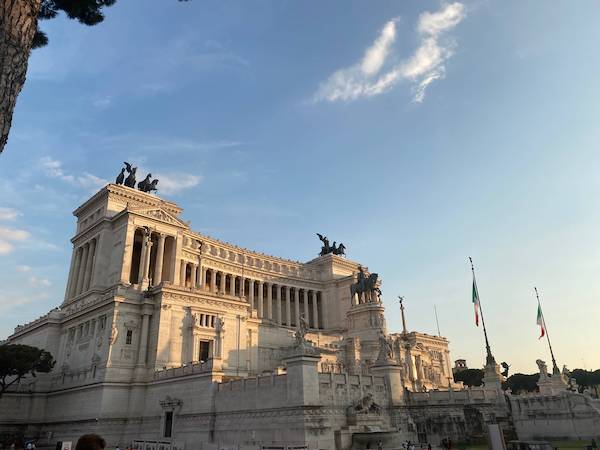
Vittoriano is a large, tall, white building: it has the shape of an ancient altar (or as many say: the shape of a typewriter!), it has a neoclassical architecture appearance and statues of winged Victories on top.
It is also crowd by an equestrian statue of the king, which is one of the most recognisable statues in Rome.
It is one of the most distinctive landmarks in Rome and you cannot miss in, when visiting the square!
Vittoriano takes its name from King Vittorio Emanuele and it is an interesting monument to visit.
The monument has interesting and beautiful architecture, it houses several museums and has several stunning terraces stunning views over Rome from different angels.
You can find here >>> our complete guide to Il VIttoriano
Hadrian’s Auditoria
Since 2021, a new archaeological area has become visible in Piazza Venezia: Hadrian’s Auditoria.
This dig came to light during excavation works for the new metro line C, due to pass through the piazza and it is an interesting example of Roman architecture from the II century AD.
The complex goes by the name Hadrian’s Auditorium or also Hadrian’s Athenaeum and was devoted to debates and public meetings.
The area is below street level and there are viewing platforms with info panels detailing what it is and its history, allowing to admire it.
Palazzo Venezia
Palazzo Venezia is a larghe, severe looking building overlooking the square.
The building oyesses its name to the republic of Venice, which has its embassy here.

However, it is most commonly remembered as the seat of the Head of Government and of the Grand Council of Fascism under Mussolini and the palace from where he announced the declaration of war agains France and the Great Britain in 1940.
The building is medieval in origin and still retain a beautiful cloister with greenery and plants, open to the public and free to visit.
Inside, Palazzo Venezia now houses Museo Nazionale fi Palazzo Venezia (Palazzo Venezia National Museum).
Its collections include works of art coming from Castel Sant’Angelo, a significant ceramics collection (Wurtz collection), the Ruffo collection of prints, paintings, and furniture and noticeable bronze collections.
You can find info and tickets here
Palazzo delle Assicurazione Generali
Palazzo delle Assicurazioni Generali is a tall, elegant palazzo overlooking Piazza Venezia.
It is an interesting examples of Renaissance architecture in Rome (Outside only, no public access).

Spelacchio: Rome’s most famous Christmas tree
At Christmas, Piazza Venezia acquires a Christmas tree, one of the main festive focal points of the city.
The tree is usually tall, pretty and healthy looking.
However, a few years the chosen tree had a particularly unfortunate, unhappy look and Romans were quick to name it accordingly. We called it Spelacchio (lit. Scraggy) and the name stuck!
Now ever year, even if the tree looks ok or even beautiful, the city recalls the ghost of spelacchio, now a staple of local culture and irony.
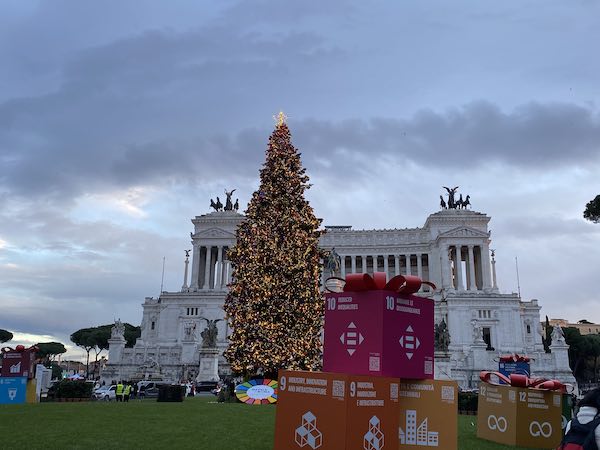
Trajan’s Column
Trajan’s column is one of the most interesting ancient columns in Rome and a sight worth seeing.
Located Immediately outside Piazza Venezia, on Via Dei Fori Imperiali, the columns is a free standing monument famous for elaborate carvings all along its body.
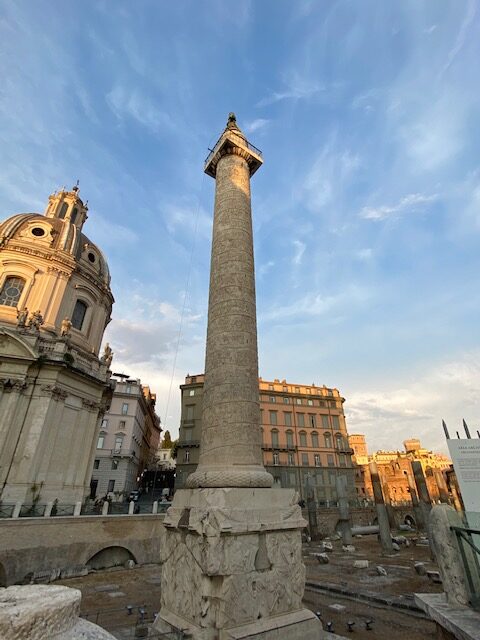
The sculpture represent the successful war campaigns of Emperor Trajan in the II century AD and they are the first example of ancient Roma sculpture used for story telling purposes.
You can read all about it and its history in our visitors’ guide to the Column of Trajan in Rome.
The statue of Madama Lucrezia
Just beside Piazza Venezia, in the corner of the square known as Piazza San Marco, stands a peculiar statue known as the statue of Madama Lucrezia.
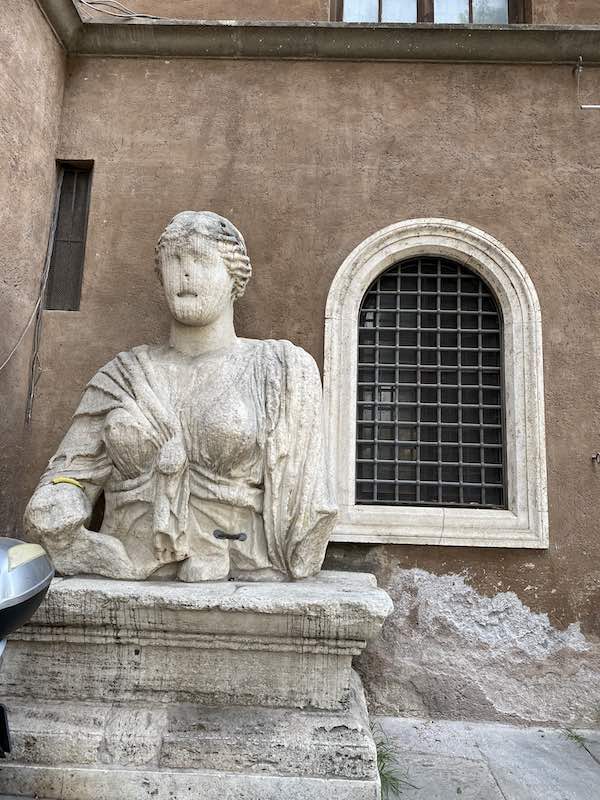
The statue is a tall bust and head of a woman, probably from Roman times and probably, in origin, a representation of the Goddess Isis, one of the most popular Rome Goddesses in imperial times.
Romans however know her as Madama Lucrezia and count it among the talking statues of Rome, statues used in Papal time to express discontent for public policies!
You can read here >>> all about the talking statues of Rome.
Fontana della Pigna in Piazza Venezia
On the same side of the piazza as Madama Lucrezia, there is a fountain knowns as Fontana della Pigna.
This is one of the so called ‘Fontane rionali di Roma’ (Rome’s neighborhood fountains) built in 1929 by architect Lombardi.
Each of these fountains had symbols aimed at recalling something about their area: in this case, the choice fell on a pinecone (Pigna, in Italian), which is also the name of this neighborhood: Rione Pigna.
You can read here >>> all about Rome’s Rioni
Where to eat in Piazza Venezia
Piazza Venezia is beautiful but very trafficked, therefore I recommend against eating on the square.
Instead, I recommend you climb to the mid-terrace of the Vittoriano (free) and have a snack or a drink at the cafe on Terrazza Italia, beautiful and quiet.
As an alternative, you can have lunch in nearby Birreria Peroni (casual) or stretch to the nearby Ghetto area, famous for its excellent Jewish-Roman cuisine.
Where to stay near Piazza Venezia
Piazza Venezia is right in the center of Rome; therefore, many city center hotels in the Pantheon / Trevi / Roman Forum area are nearby.
Among the closest to the piazza and best, we recommend:
NH Collection Rome Fori Imperiali – overlooking piazza Venezia and Trajan’s Column, this is a nice 4 star hotel in stellar location and with a fantastic panoramic terrace overlooking the square and Vittoriano
Otivm Boutique Hotel – delightful, romantic small hotel just beside the piazza, with a spectacular rooftop terrace with views over the Capitoline Hill
Nerva Boutique Hotel – only a couple of minutes from Piazza Venezia, this is a nice hotel in stellar location for sightseeing and to enjoy Ancient Rome in particular
Buses serving Piazza Venezia
Piazza Venezia is a trasport hub and operates as terminus of many buses including: 40, 63, 70, 75, 81, 87, 95, 160, 170, 204, 628, 630, 716.
I hope you enjoyed this quick travel guide to Rome’s Piazza Venezia and it helped you plan your stay in Rome! Safe travels.
Not sure how to include this attraction in your Rome itinerary? Check our Rome itinerary suggestions below:
Rome in a day: detailed Rome city centre itinerary for first time visitors
Rome in two days A detailed itinerary for two full days in Rome
Rome in three daysRome in four days – day-by-day 3 day Rome itinerary
Rome in five days – complete Rome itinerary with main attractions and less usual sites for visitors with more time in the city
Traveling to Rome with kids? Find our family guide to Rome here.
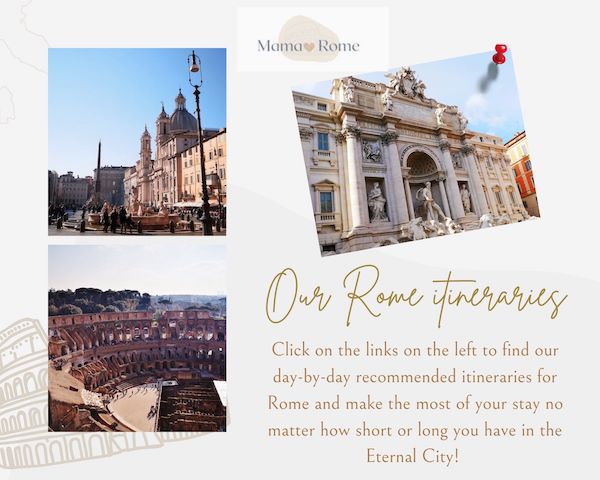
Essential visitors’ guide to Piazza Venezia – pin this!

